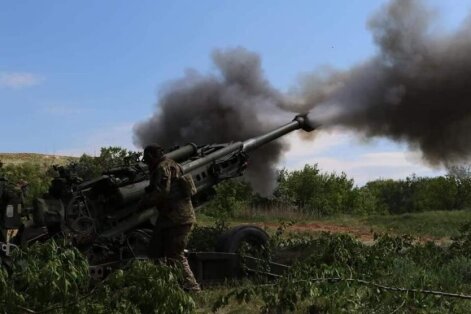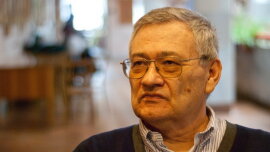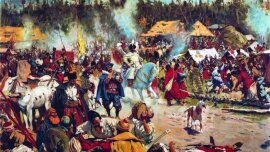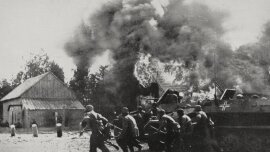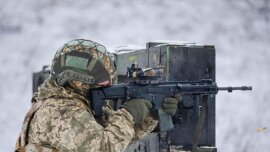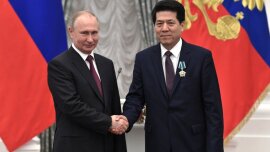The collapse of an ambitious Russian strategic operation aimed at carrying out a large-scale encirclement of Ukrainian forces in the Donbass region is now seen by two warring parties as a fact. The inability of the Russian army to break the Ukrainian defenses on the northern flank of the Donbass ledge in the Izyum area and on its southern flank in the Kurakhovo area led to a marked appeasement of the unsuccessful side's ambitions. As a result, the Russian command decided to turn the Donbass fortified area into the center of its military efforts.
However, the course of action of Russian troops suggests a cautious hypothesis - the advancing side did not completely abandon the implementation of a major sweeping maneuver, but decided to implement it in another strategic combination, which in this essay is defined as "Falkenhain's formula." Its essence can be represented by analyzing the German concept of the Verdun operation of 1916.
It should be noted at once that the validity of the experience of one of the bloodiest battles of the First World War in the context of the review of the current stage of the battle for Donbass stems from the following grounds: first, the German command sought to eliminate guidance; secondly, the corresponding operations of the German Empire and Russia involved frontal strikes on the enemy's fortified points; thirdly, the position of the German side allowed it to attack the flanks of the defending French troops, while at present the Russian side has similar advantages over the Ukrainian troops.
Taking into account these three parameters, we can proceed to the description of the plans of the Chief of the General Staff of Germany Erich von Falkenhain. According to the General of the Infantry, the sharp-edged ledge at Fort Duomon, a key point in the fortified area of Verdun, provided broad prospects for a comprehensive maneuver, the successful implementation of which improved Germany's position on the Western Front. The project of the offensive provided that the main attack (der Hauptstoß) of German troops, aimed at a system of forts on the east bank of the river Meuse (began February 21, 1916), was to force the French command to deploy forces from its west bank to offset a potential breakthrough.
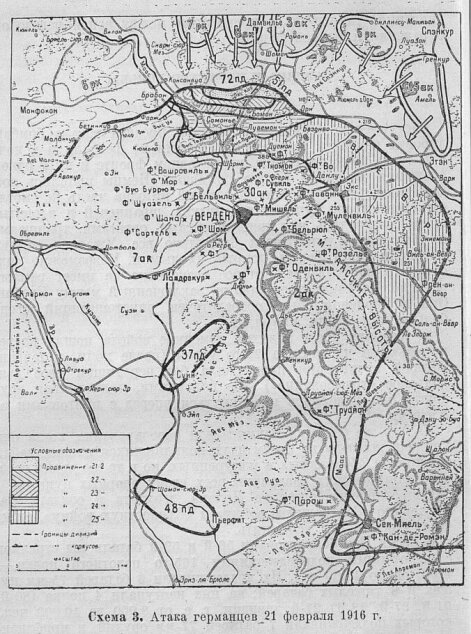
Strictly after these erroneous countermeasures [1] , it was planned to strike a second, flank attack on the enemy's already weakened defenses on the West Bank ( [ March 5, 1916).
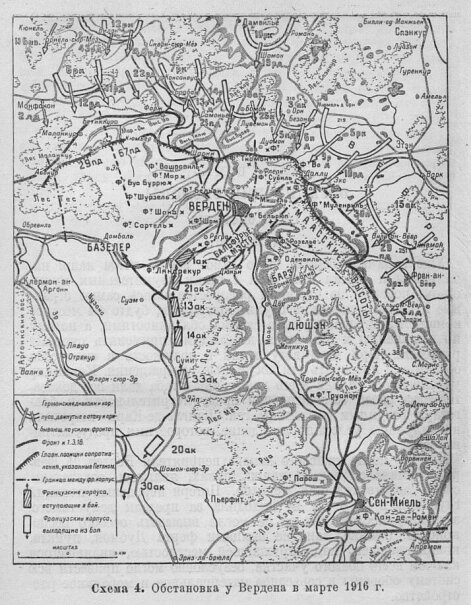
Examining the German plan, Captain Basil Liddell Garth concludes that it was in fact a revival of the "sedan" double coverage in 1870. The high probability of success of such a maneuver was achieved thanks to the wedge at Saint-Miel, which was beneficial for the Germans "sharpened" the Verdun ledge. In addition, the river Meuse, which crossed the area defended by the French, significantly complicated the process of counteracting German ticks. This is due to the following circumstances: the repulse of frontal attacks, as noted above, could force the French command to send reserves to the east bank and, accordingly, in the event of a new attack on the west bank, it became for the republic's troops, in the language of a British military theorist. to the prison wall, behind which the Germans were given the opportunity to defeat the French rear and repeat the triumph of September 1, 1870. On a more global scale, according to Liddell Garth,[4] .
Thus, in its ideal expression, the "Falkenhain formula" involves a two-phase operation. In its first stage, the attacking side draws the enemy into battles, geographically concentrated directly on the leading edge of the ledge zone, and brings the clashes to such an extent as to require the defending side to introduce reserves; in the second stage, the attacker uses this mistake of his opponent and performs a sweeping maneuver, which is difficult to counter due to the lack of defenders necessary to repel it.
This naturally leads to the hypothesis that the Russian command is currently implementing the first stage of the proposed plan. In particular, the main strike [5] in the southern, eastern and northern parts of the Donbass ledge (triangle Popasnaya, Lisichansk, Seversk) should turn it into a zone of absorption of Ukrainian manpower and equipment. Further, in the second stage, when the reserve forces of the defenders will be involved in grueling battles on this section of the front, the Russian command will move to increasing flank pressure in the Kurakhovo and, above all, Izyum directions.
An argument in favor of this assumption is the recent occupation of the Lyman by the Russians - a hub that ensures the development of two phases of the strategic "Falkenhain formula". The occupied city is becoming a base to develop an offensive to the southeast to threaten to force the Seversky Donets River and automatically increase tensions in the northern part of the Donbass ledge in the Seversk area (first phase), and to the southwest to provide pressure on Slavyansk. northern coverage of the Izyum group of Russian troops (second phase) [6] .
However, if the hypothesis about the plans of the Russian command is correct, the implementation of the proposed operation will encounter known processes of friction and degenerate to the state of "Maasmühle" (die Maasmühle), which in 1916 physically and spiritually ground the warring parties, but did not lead to fracture on the Western Front. In general, according to Liddell Garth, Falkenhain himself did not have a clear idea of his own plan, but relied on certain coincidences [ 7] (for example, the moral collapse of France) that could change the course of the battle itself . It is obvious that eventually the Russian command will also face a "game of chance" around breaking the defense of its opponent.
With regard to the Ukrainian side, it can be said that its command faces the difficult task of verifying the defensive use of troops both directly in the sector of the Donbass ledge and on its flanks. Based, among other things, on the experience of the Battle of Verdun, military strategist Edward Luttwak warned in every possible way . [9]from persisting in the imperative retention of such zones, as the defending party may be faced with the possibility of bleeding its own army, approaching material depletion and the occurrence of reputational costs. On the other hand, it is obvious that as long as the attacking side suffers much more damage than the defending one, and the general strategic situation on the front does not threaten the development of the Falkenhain formula, maintaining the zone is justified. Moreover, the experience of Marshal Henri Philippe Pétain's actions shows that holding persistent positions in the position de résistance of the ledge allows to gain time to prepare the position de barrage in its rear areas [10]. That is why the degree of flexibility with which the Ukrainian command will approach the Donbass dilemma and use the resilience of its troops in its current resistance positions to organize "fire" lines of defense will determine the depth of Russia's advance and the position of the entire Eastern Front.
In conclusion, it should be noted that the proposed concept of the Russian operation was born in the same situation as its more than a century-old predecessor - now Russia's military leadership, as well as the German command in 1916, using a geographically advantageous zone, tries to put the only possible positional deadlock a powerful frontal blow to the service of a comprehensive maneuver. Before us is the triumph of the views of Karl von Clausewitz, who defined [11] strategy as the use of combat for war purposes [12] . The battle unleashed by Falkenhain proved the futility of appealing to this principle and the high probability that the development of the Battle of Donbass will confirm the legitimacy of such a conclusion.
[1] In this regard, Erich von Falkenhain writes in his memoirs: "Der Generalstabschef entschied sich deshalb dafür, den Westangriff später als den Hauptstoß beginnen zu lassen".
[2] Falkenhayn E. Die Oberste Heeresleitung, 1914-1916, in their most important conclusions. Berlin: ES Mittler und Sohn, 1920. S. 192-193.
[3] A similar view was shared by Marshal Henri Philippe Pétain, who was able to decipher his plan vis-à-vis. For more details, see Pétain Ph. The battle of Verdun. Paris: Payot, 1929. P. 31-32.
[4] Liddell Hart B. History of the First World War. London: Cassell, 1970. P. 288.
[5] Note that in the Popasna area, Russian troops used the same tactics as the Germans during the Verdun operation in the Braban, Orne, and Verdun triangles, creating a "death zone" by concentrating artillery fire on a small section of the front.
[6] "Falkenhain's Formula" organically complements the project of the Russian offensive, based on the experience of the Barvenkov-Lozov operation in January 1942. Relevant materials were published in the article "Notes on Ukraine's strategic position: the goals of Russia's offensive in the east."
[7] Liddell Hart B. Op. sit. P. 288.
[8] In a sense, the capture of Fort Duomon was a manifestation of such a "coincidence". The seemingly impregnable fortress fell thanks to the courage and resourcefulness of 24-year-old non-commissioned officer Felix Otto Kunze of the 24th Brandenburg Regiment. Entering the fort, the enterprising German discovered the actual absence of a French garrison.
[9] Luttwak E. Strategy: the logic of war and peace. Cambridge, London: The Belknap Press of Harvard University Press, 1987. P. 47-48.
[10] Pétain Ph. Op. sit. P. 59.
[11] von Clausewitz C. Vom Kriege: hinterlassenes Werk des Generals Carl von Clausewitz. Berlin: Richard Wilhelmi, 1883. S. 116.
[12] "The strategy is the use of the war for the purpose of war".
